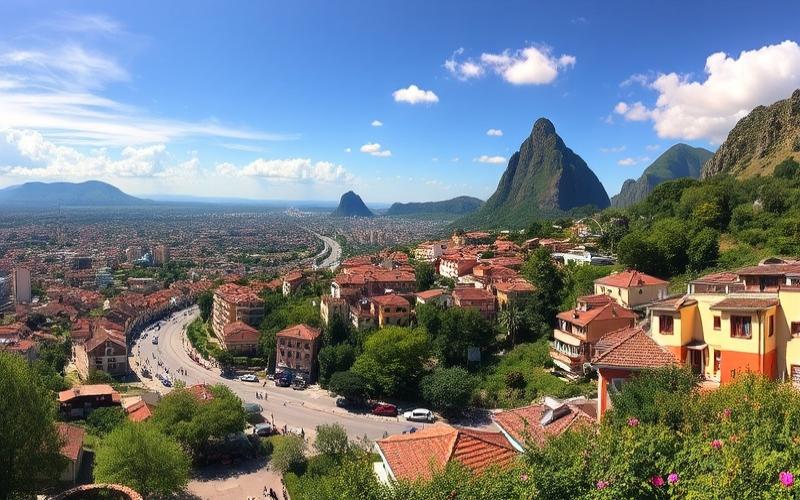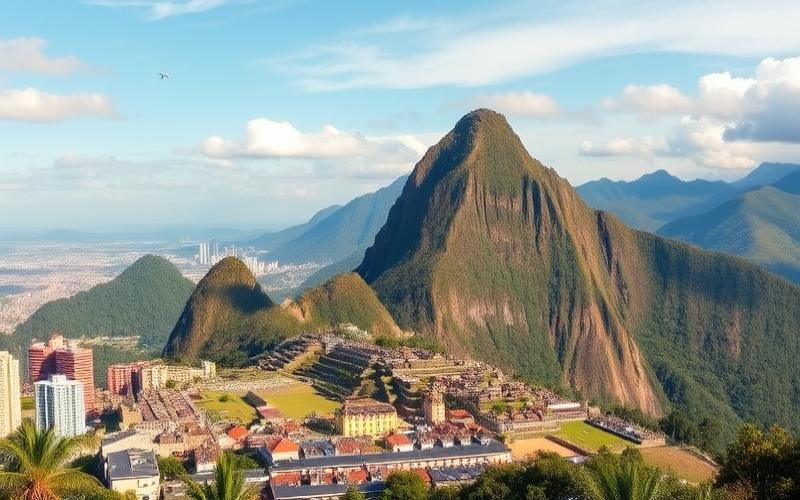
 Published on and written by Cyril Jarnias
Published on and written by Cyril Jarnias
In an emerging country like Brazil, where real estate offers enticing investment opportunities, real estate crowdfunding is emerging as an innovative solution, enabling a wide range of investors to participate in projects once reserved for large capital.
This crowdfunding mechanism, which aims to democratize access to the real estate market, relies on collecting funds from multiple small contributions, thus paving the way for portfolio diversification for those wishing to invest in real estate without mobilizing vast sums of money.
By leveraging digital and transparent platforms, crowdfunding not only transforms how real estate projects are funded, but it also offers a new approach to navigating the dynamic Brazilian real estate ecosystem.
Real Estate Crowdfunding in Brazil: An Innovative Solution
The Brazilian real estate market experienced a boom phase in the 2010s, followed by a correction and recent stabilization with a measurable recovery in prices, the housing index reaching a record in 2025, reflecting a cyclical recovery and renewed demand in several segments. Faced with regional disparities (stability in major metropolises, moderate growth in secondary cities, strong appreciation in tourist areas) and a structural deficit of affordable housing, real estate crowdfunding emerged as a solution to diversify funding sources and broaden investment access, particularly for individuals seeking lower entry tickets and better geographical diversification.
Context and Recent Dynamics
- Price stabilization in São Paulo and Rio after the post-boom correction, with local increases for quality properties.
- Sustained growth in secondary cities (e.g., Curitiba, Belo Horizonte) and strong appreciation in tourist areas (e.g., Búzios, Trancoso) attracting rental investors.
- Rising national indicator: the housing index peaks in July 2025, reflecting an overall bullish market despite regional contrasts.
Emergence and Operation of Real Estate Crowdfunding
- Principle: pool capital from many investors to fund projects (development, renovation, rental operations), via digital platforms that present the project, the sponsoring company, funding needs, timeline, and target return.
- Common models:
- Debt: loans to developers with fixed interest and defined maturities.
- Mezzanine debt: higher yield, intermediate risk.
- Equity: stake in an SPV, return via capital gains and/or dividends.
- Typical process: platform due diligence, risk disclosure, 100% online subscription, construction site monitoring and periodic reporting, repayment at maturity with interest or income distribution.
Main Platforms and Positioning in Brazil
- Specialized “real estate crowdfunding” platforms: selection of residential and mixed projects in major metropolitan areas, with low entry tickets (often a few hundred to thousands of R$), maturities of 6 to 36 months, and monthly construction reporting.
- Broader investment platforms including real estate: structured debt offerings linked to unit inventories, construction pre-funding, or pre-sales project refinancing.
- Key differentiators: depth of due diligence, transparency of indicators (default rates, delays), security mechanisms (trust, real guarantees), and integration with native channels (e.g., tracking via WhatsApp), a channel that has become dominant in the Brazilian real estate ecosystem.
Impact on Accessibility for Individuals
- Lower entry barriers: low tickets, access to metropolitan markets previously reserved for institutional investors.
- Diversification: ability to spread across multiple cities/segments (mid-market, Minha Casa Minha Vida, tourist rentals), reducing specific risk.
- Transparency and education: dashboards, construction updates, information standardization, supported by digital tools and customer automation that streamline the investment journey.
Concrete Examples of Successful Projects
- Urban residential: pre-funding construction of a medium-sized building in Belo Horizonte, raised in days via a platform, with bullet repayment and interest on time, illustrating appetite for dynamic secondary markets.
- Tourist rental: renovation of a small complex in a sought-after coastal area (e.g., Búzios), funded by a short-term debt issue, driven by strong demand for second homes and high-end stays, resulting in early exit due to pre-sales.
- Unit inventory in Rio: refinancing operation backed by pre-sold units in revitalizing neighborhoods, enabling faster deliveries without relying solely on traditional bank credit.
Regulation and Oversight Framework
- Oversight by the capital markets regulator, with transparency requirements, risk disclosure, and platform licensing.
- Standard rules: fundraising caps by status, offer classification (public/limited), reporting obligations, fund custody via segregated accounts, and KYC/AML procedures.
- Recent trends: process professionalization, reporting standardization, and increased use of digital tools (chatbots/automation) for traceability and service quality, boosting retail investor confidence.
Opportunities
- Broadened access to real estate returns, with low tickets and diversification.
- Accelerated construction and increased liquidity for developers, especially in growing secondary markets.
- Enhanced transparency and better service standards (real-time tracking, digital channels) reducing transactional friction.
- Cyclical alignment: measured price recovery and demand in targeted segments, increasing exit viability.
Risks
- Developer credit risk: delays, cost overruns, or defaults, potentially extending duration or reducing returns.
- Market risk: price volatility by region and cycle, sensitive in tourist areas.
- Liquidity risk: inability to sell position before maturity.
- Regulatory/operational risk: platform governance, fund segregation, and due diligence quality; dependence on project execution and monitoring.
- Geographic concentration: overexposure to a single city/segment.
How Crowdfunding Transformed the Real Estate Landscape
- Investment democratization: influx of retail investors and broadening of developer funding base.
- New go-to-market mechanisms: pre-sales backed by investor community, faster funding cycles, and greater reporting discipline.
- Data and user experience enhancement: project information standardization and real-time conversational support, especially via WhatsApp, becoming a key acquisition and retention vector in Brazilian real estate.
- Better coverage of non-primary markets: funding projects in secondary cities where traditional credit access is more restrictive, aligning with the moderate but steady growth of these markets.
Summary Table: Access and Risks for an Individual
| Aspect | What Crowdfunding Changes | Points to Watch |
|---|---|---|
| Entry Ticket | Low: a few hundred to thousands of R$ | Don’t oversize a single operation |
| Diversification | Multi-project, multi-city | Sector correlation in case of downturn |
| Return | Fixed interest or capital gains | Delays/defaults affecting IRR |
| Liquidity | Online subscription/management | Limited exit before maturity |
| Information | Standardized reporting, digital tracking | Quality and independence of due diligence |
| Securities | Possible guarantees/trusts | Verify rank and coverage value |
List of Best Practices for Individual Investors
- Spread investments across multiple projects, maturities, and regions.
- Examine platform history: default rates, delays, recoveries.
- Understand structure: debt vs equity, real securities, priority rank.
- Validate local fundamentals: demand, pre-sales, price/m², neighborhood dynamics.
- Plan for illiquid horizon and risk cushion.
Real estate crowdfunding in Brazil has gained relevance because it simultaneously addresses three constraints: developers’ funding needs, individuals’ desire to access real estate with low tickets, and regional market heterogeneity requiring diversification and transparency.
Good to Know:
Real estate crowdfunding in Brazil has emerged as a promising solution to the challenges of an evolving real estate market, such as rising prices and limited accessibility for small investors. Platforms like URBE.ME and Bloxs allow individuals to invest with modest initial capital in projects that would otherwise be inaccessible. By pooling funds from many small investors, these platforms have facilitated the funding and completion of numerous real estate projects, such as residential development in Curitiba and commercial space in São Paulo. Regulation by the Securities and Exchange Commission (CVM) provides some investor protection, although certain risks remain, such as market volatility and non-guaranteed returns. This funding method has not only diversified investment opportunities but also democratized access to real estate, thereby transforming the Brazilian economic landscape by offering new growth perspectives to the sector.
The Benefits of Crowdfunding Investment in Brazil
Real estate crowdfunding in Brazil enables portfolio diversification with modest entry tickets, well below amounts required for direct purchase or traditional real estate funds, by pooling contributions from multiple investors and providing access to pre-analyzed projects.
- Access with low stakes and ability to increase exposure gradually, facilitating diversification by project, developer, city, and type (residential, commercial).
- Opportunities to invest in local projects (e.g., dynamic markets like São Paulo, where residential fundamentals are supported by demographics, employment, and income) and access international operations via platforms operating in multiple jurisdictions.
- Risk reduction through enhanced transparency: projects vetted upfront, centralized information (developer, business plan, risks, timeline), execution tracking, and standardized selection processes.
- Contribution to local economic development: funding new housing, supporting Brazilian developers, job creation, and stimulating the real estate value chain; institutional partnerships in residential attest to market depth and sector innovation.
- Potential for high returns compared to some conventional investment forms, thanks to fixed-term projects, mezzanine or private real estate debt tickets, and specific development risk premiums.
Comparative Table: Real Estate Crowdfunding vs. Traditional Real Estate Investments
| Criterion | Real Estate Crowdfunding | Direct Purchase / Traditional Funds |
|---|---|---|
| Entry Ticket | Low (progressive access) | High (down payment, fees) |
| Diversification | Facilitated by project/city/developer | Limited by required capital |
| Project Transparency | Standardized dossiers, tracking | Variable by vehicle |
| Liquidity | Medium to low (by project) | Variable (low direct, moderate via funds) |
| Potential Return | High with risk premium | Moderate to high with leverage |
| Local Impact | Direct (construction funding) | Indirect |
Practical Points for the Investor
- Define a basket of projects (10–20) to smooth idiosyncratic risk.
- Prioritize platforms clearly indicating developer, schedule, guarantees, and stress tests.
- Target Brazilian markets with strong fundamentals (e.g., São Paulo) and, if desired, complement with projects outside Brazil via eligible platforms.
- Verify governance, due diligence, and interest alignment (developer tickets, delay penalties).
Good to Know:
Real estate crowdfunding in Brazil allows investors to effectively diversify their portfolios, often with more modest amounts than traditional investments, offering the opportunity to access a wide range of local and international projects. This system promotes risk reduction through enhanced transparency and better accessibility of information on each project, facilitating more informed investment decisions. Moreover, investors can actively participate in local economic development and innovation in the real estate sector by supporting projects that stimulate community growth. Finally, this investment method offers the potential for high returns, often superior to some traditional investment forms available in Brazil.
How to Choose Crowdfunding Platforms in Brazil
Essential criteria for choosing a real estate crowdfunding platform in Brazil:
- Regulation and certification: verify licensing and compliance with CVM (Comissão de Valores Mobiliários) and adherence to public offering rules for SME crowdfunding, including fundraising caps, intervals between offers, and investment limits by investor profile.
- Information transparency: requirement for clear data rooms on each real estate project (developer, legal structure: debt/bonds or shares/equity, guarantees, market studies, timeline, exits, risks, stress tests), published selection policies and default rates, and explicit IRR/return methodology.
- Fees and commissions: identify platform-level fees (entry/subscription fees, annual management fees, performance commissions) and project-level fees (investment vehicle fees, legal fees, custody, exchange if applicable).
- Reputation and history: years of activity, total amount raised, number of successfully closed projects, default/delay rates, quarterly reporting consistency, media presence, and external audits.
- Customer service and support: availability in Portuguese and possibly English, response times, channels (chat, phone, email), quality of FAQs and knowledge bases, educational webinars, access to legal documentation.
- Investment framework: adherence to fundraising limits (180-day offer period, minimum interval before new offer) and investment caps for retail and qualified investors, 7-day right of withdrawal.
- Risk management: sector and geographic diversification, presence of real guarantees (trust, mortgage), subordination clauses, SPV governance, sensitivity scenarios (costs, timelines, sales), recovery policies.
- User experience: dashboard, real-time construction reporting, coupon/dividend distribution, tax documents, local banking integration (PIX), smooth KYC/AML procedures.
- Interest alignment: possible platform co-investment, compensation primarily upon success, transparency on conflicts of interest.
Examples of recognized platforms in Brazil and quick analysis:
- Example A: Brazilian platform focused on SME/real estate compliant with CVM (offers up to 5 M BRL over 180 days; 7-day withdrawal). Advantages: access for individuals, clear framework, low entry tickets. Limitations: fundraising caps, advertising restrictions, allocation limits for retail investors.
- Example B: platform oriented towards real estate equity. Advantages: return potential linked to project performance; alignment via shares. Limitations: exit volatility, unfavorable payment hierarchy vs debt; more complex taxation and governance.
- Example C: platform oriented towards developer debt/bonds. Advantages: set schedule and rates, better cash flow visibility. Limitations: developer default risk, construction delay risk; dependence on guarantee quality.
Specific Advantages and Disadvantages by Platform Type
| Platform Type | Model (debt vs equity) | Key Advantages | Key Disadvantages | Suitable Investor Profile |
|---|---|---|---|---|
| CVM-compliant dedicated SME/real estate | Debt or equity | Regulated framework, 7-day withdrawal right, exposure limits to protect retail | Fundraising caps (up to ~5 M BRL) and offer windows; marketing restrictions | Beginners to intermediates seeking supervised framework |
| Developer debt/bonds | Debt | Contractual return, defined maturities, payment priority vs equity | Sensitive to delays/failures; guarantee quality decisive | Cautious profile preferring cash flow visibility |
| Real estate equity (SPV/shares) | Equity | Upside on performance, developer alignment | Subordination, longer horizon, tax/governance complexity | Higher risk tolerance, long horizon |
Concrete Checklist Before Investing:
- Confirm platform registration/compliance and adherence to applicable CVM framework, including fundraising and investment limits.
- Examine project sheet: developer, permits, market study, budget (contingencies), timeline, exits, guarantees, debt rank.
- Read legal documentation: term sheet, subscription contract, shareholder agreement/indenture, guarantees, withdrawal (7 days) and exit rights.
- Compare total fees (platform + vehicle + transaction) and impact on net return.
- Verify history: published default/delay rates, repaid amounts, number of closed projects, return calculation method.
- Test customer service (SLA, languages, channels) and reporting quality (construction photos, KPIs).
- Assess specific Brazilian risks: exchange risk if foreign investor, local legal risk, construction and marketing risks.
Key Brazilian Regulatory Points of Attention:
- Fundraising cap per offer for small businesses and 180-day offer window; waiting period before new offer.
- Investment limits: annual cap for retail investors; thresholds based on income/assets for qualified.
- Right of withdrawal: possibility of refund within 7 days after investment.
Diversification Best Practices:
- Spread across 8–15 projects, different developers and cities.
- Mix short debt (12–24 months) and longer-term equity.
- Limit exposure to a single developer or type (residential vs logistics).
- Reinvest repayments to smooth temporal risk.
How to Compare 2 Brazilian Platforms in 5 Minutes:
| Criterion | Platform 1 | Platform 2 |
|---|---|---|
| CVM Compliance (offers, limits, withdrawal) | ||
| Project Transparency (data room, stress tests) | ||
| Total Fees (platform + vehicle) | ||
| History (default/delay rates, repaid amounts) | ||
| Guarantees and Rank (mortgage/trust) | ||
| Reporting Quality and UX | ||
| Customer Service (SLA, languages) |
Tips for Foreign Investors:
- Verify KYC eligibility and local tax requirements; anticipate BRL exchange risk.
- Prefer projects with robust local guarantees; understand recovery mechanisms.
- Check cross-border advertising and distribution restrictions imposed by CVM.
Common Mistakes to Avoid:
- Relying on gross return without integrating fees and taxation.
- Ignoring equity subordination and real guarantee value.
- Concentrating too much capital on a single developer or city.
- Neglecting withdrawal rights and specific Brazilian regulatory deadlines.
Good to Know:
When choosing a real estate crowdfunding platform in Brazil, it is crucial to verify its regulation by the Comissão de Valores Mobiliários (CVM) to ensure reliability. Make sure the platform provides clear and transparent information on proposed projects, including associated risks. Compare fees and commissions charged, which can vary significantly between platforms. Look for those with a good reputation and proven track record of success, such as Bloxs Invest or Urbe.me, recognized for their rigor and efficiency. Urbe.me is often praised for its project transparency and user-friendly interface, while Bloxs Invest is appreciated for its sector diversification. Also consider customer service quality and investor support options, essential for effectively addressing your needs.
What Are the Risks and Considerations to Take Into Account
Risks associated with real estate crowdfunding in Brazil are significant and require thorough analysis of financial, legal, tax, and market dimensions, as well as rigorous platform selection and methodical investment diversification.
Financial Risks
- Capital loss total or partial in case of developer default or project failure.
- Project delays (shortages, budget overruns, contractor bankruptcy) leading to prolonged cash immobilization and effective return erosion.
- Liquidity risk: difficulty exiting before maturity, frequent absence of secondary market.
- Rising funding costs and risk premium contraction in tight cycles, potentially degrading operations’ economic balance and increasing defaults.
Legal and Regulatory Risks
- Non-compliance risk of project (permits, urban compliance, contracts) and exposure to litigation or cancellations.
- Risk related to project sponsor: insufficient governance, weak guarantees, conflicts of interest.
- Need to understand local regulatory barriers (distribution rules, platform status, information requirements, guarantees), under penalty of contract nullity or unenforceability risks.
Market Risks
- Real estate price volatility and construction costs, potentially degrading margins and extending marketing timelines.
- Macroeconomic shocks (rates, credit, economic conditions) correlated with increased delays and bankruptcy proceedings.
Potential Tax Implications for the Investor
Income generally taxed as interest or capital gains depending on instrument (debt, bonds, shares), with specific withholdings and declarations; treatment differences may exist between residents and non-residents and according to tax treaties.
Fees and potential losses not always tax-deductible; importance of tracking flows and anticipating cross-border taxation if applicable.
Importance of Platform Choice
Prefer regulated platforms, with performance history, low default/delay rates, detailed reporting, and security mechanisms (mortgage, trust guarantee), keeping in mind that no repayment guarantee is automatic.
Examine transparency: project information, administrative documents, stress tests, exit scenarios, fee structure, conflict of interest management policy.
Diversification to Reduce Risk
Diversify by developers, asset types (residential, logistics, offices), geographic areas, maturities, and structures (senior, mezzanine, equity) to limit impact of idiosyncratic default.
Avoid temporal concentration; stagger commitments to smooth cycle risk.
Transparency and Prior Due Diligence
Verify:
- The authorizations (permits, licenses), land, insurance, contractor contracts.
- The detailed budget, capital structure, pre-sales level, covenant clauses, nature and rank of guarantees.
- The sponsor’s execution capacity: track record, delivery rate, litigation, governance.
- The cash flow schedule and safety margins against rate/cost increases.
Require periodic reports and key indicators (technical progress, sales, incurred vs budgeted costs, DSCR, delays) for dynamic risk monitoring.
Table — Pre-Investment Checkpoints
| Legal framework and platform status |
| Published default/delay rates |
| Guarantees and security rank |
| Permits and technical due diligence |
| Financial structure and covenants |
| Sensitivity scenarios (rates, costs, prices) |
| Developer history |
| Reporting policy and governance |
Summary of Best Practices
- Choose reputable and regulated platforms with robust reporting.
- Diversify widely by projects, sponsors, areas, and maturities.
- Analyze delays and liquidity ex ante; plan for illiquid horizon.
- Integrate taxation into expected net return and document declarative obligations.
- Implement documented due diligence on authorizations, guarantees, and execution capacity.
Good to Know:
When using real estate crowdfunding in Brazil, it is crucial to consider various financial, legal, and market risks. Investors should be aware of tax implications specific to Brazil and familiarize themselves with local regulatory barriers that can affect returns. It is recommended to opt for well-established and recognized crowdfunding platforms to reduce associated risks. Diversifying investments is essential to minimize the impact of a potentially failing project. Ensure projects offer sufficient transparency and conduct thorough due diligence before committing. This includes verifying the developer’s track record and assessing local real estate market conditions to avoid potential complications.
Disclaimer: The information provided on this website is for informational purposes only and does not constitute financial, legal, or professional advice. We encourage you to consult qualified experts before making any investment, real estate, or expatriation decisions. Although we strive to maintain up-to-date and accurate information, we do not guarantee the completeness, accuracy, or timeliness of the proposed content. As investment and expatriation involve risks, we disclaim any liability for potential losses or damages arising from the use of this site. Your use of this site confirms your acceptance of these terms and your understanding of the associated risks.






















































